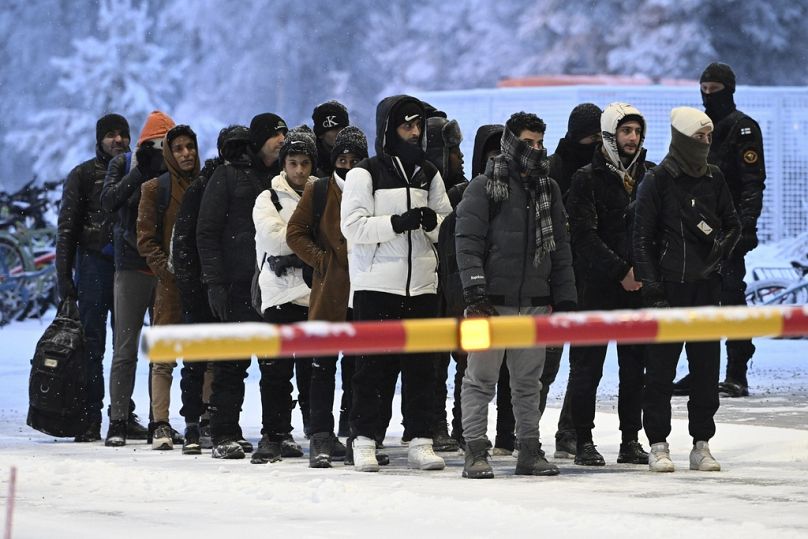Russia has been accused of weaponising migration by channelling people to the borders of Finland in recent weeks.
Estonia has said it is prepared for possible “spillover” into its territory amid an ongoing migration crisis on the EU’s eastern edge.
Finland is set to close its entire 1,300km frontier with Russia from Wednesday at midnight, following a recent spike in the number of people trying to enter the country illegally. Moscow has been accused of channelling migrants to the Finnish border as a form of “hybrid war”.
Now neighbouring Estonia, which also sits on Russia’s border, says it could be affected too, though it is yet to face similar pressure on its frontier, according to Estonian authorities.
“Finland’s decision to close all border crossings on its eastern border may not necessarily mean that the migration pressure from Russia will automatically spill over to our border crossings or the green border,” said Estonian Interior Minister Lauri Läänemets in a statement to Euronews.
“But we definitely consider that a likely scenario, so we’ve made all preparations in case of a migration spillover to Estonian borders or border points.”
Voices in the small Baltic state have called for a preventative closure of its border with Russia.
However, Läänemets said: “Considering resources and preparedness, this would not be the best approach.
“Instead of directing additional resources for preventive closures we see that it is more important for us to save our energy and resources to maintain maximum readiness. Depending on the scenarios, we might need our people elsewhere.”

The interior minister said no more migrant groups had arrived at Estonia’s north-eastern Narva border crossing over the past week, though added the country “must be prepared for a scenario when the spillover from Finland reaches directly our south-eastern green border.”
Green border refers to natural, wooded areas where there aren’t formal crossing points.
“Estonia will not let anyone without [the] legal right and paperwork to enter [the] EU and Schengen area via our border crossing points,” said Läänemets.
Around 900 people – mostly from the Middle East and Africa – have arrived on Finland’s border since August, often on brand-new bicycles.
Last week, Estonian Defense Minister Hanno Pevkur called this a “fully state-orchestrated” operation by Moscow, which he said was weaponising immigration.
Moscow has previously threatened to retaliate against Finland for joining NATO, while Estonia and the EU more generally are in the firing line for their support of Ukraine as it battles the Russian invasion.
“Based on what we know so far, migrants do not make it to the EU borders independently and without support and guidance,” said Interior Minister Läänemets. “What we see is an orchestrated migration operation which could not possibly take place without the involvement of Russian authorities and special services.”
Russia has denied it is encouraging undocumented people to the border.
Observers have claimed Moscow could be trying to destabilise the EU member states, with a border crisis potentially deepening social polarisation and political divisions.
However, Läänemets pushed back against this.
“In a broad sense, it is interesting how Russia’s attempts to divide Finnish society using migration pressure has failed and instead it has tied Finland closer to the Baltic states and Poland that have faced similar hybrid attacks over the past years,” he said.
“With its actions, Russia is giving yet another push for the EU to rethink its approach to migration. We need to tackle illegal migration not only to protect our own security and free movement of [the] Schengen Area, but also to protect innocent people from 3rd world countries from being weaponised as pawns whether by hostile countries in hybrid warfare or by organized crime for illegal profit.”
In what has been called Europe’s forgotten migration crisis, Belarus has channelled people to the borders of Lithuania and Poland since 2021 amid a geopolitical spat.
Besides pressing humanitarian concerns, rights groups have condemned the response of the Lithuanian authorities who have been widely accused of violently pushing people back into Belarus, while subjecting thousands to inhumane conditions and torture in detention camps, according to Amnesty.
Latvia also suffered the same crisis over the past few months on its borders with Belarus.
An average of 100 “illegal migrants” tried to enter Latvia from Belarus daily in October, with Estonian authorities having earlier dispatched its border forces to help Riga, said Estonia’s Interior Ministry in a separate statement sent to Euronews.
Source : Euro News















